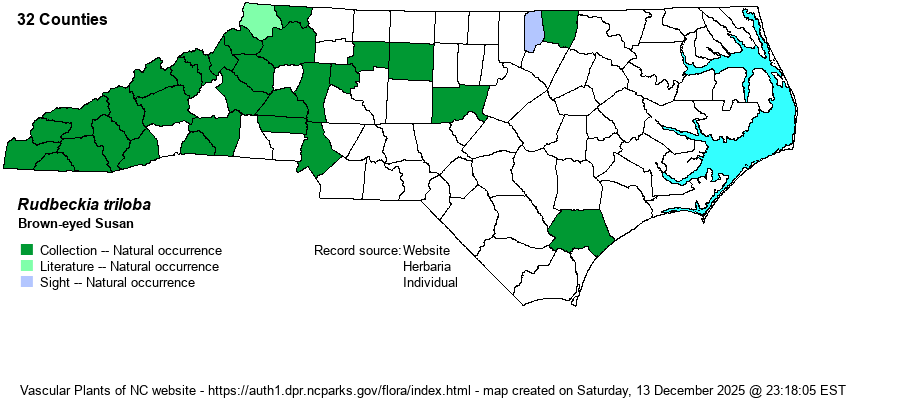| Author | L. | |
| Distribution | Mountains and Piedmont; disjunct to a limestone-influenced savanna in Pender County. Scarce over parts of the northern Piedmont and the southeastern Piedmont.
NY to Ont. and MN, south to GA and TX. | |
| Abundance | Fairly common in most of the Mountains; rare to uncommon in the western half of the Piedmont, and very rare to absent in the rest of the Piedmont. Extremely rare in the lower Coastal Plain. | |
| Habitat | Moist to rich hardwood forests, edges and openings, meadows, and fields -- essentially only in circumneutral soil. | |
| Phenology | Flowers and fruits July-October. | |
| Identification | This is a tall and often robust species -- for a Rudbeckia, growing 2-3 feet tall. Unlike most others in the genus, the plant is freely branched, with stem, branches, and leaves mostly pubescent to quite hairy. Basal leaves are mostly ovate, but stem leaves mostly have 3 distinct lobes. The flowers are typical of the genus, with a dark brown to purplish-brown disk and golden-yellow rays. It should be easily identified by the many dozens of flowers on a "bushy"-looking plant, and several to numerous 3-lobed leaves along the stem and branches. | |
| Taxonomic Comments | Weakley (2018) lists three varieties in the state -- the very rare var. beadlei, the poorly known var. rupestris, and the more widespread var. triloba.
| |
| Other Common Name(s) | Branched Coneflower, Thin-leaved Coneflower, Three-lobed Coneflower. The last is, by far, the best and most descriptive common name, but Brown-eyed Susan is in more widespread usage. | |
| State Rank | S3 [S3S4] | |
| Global Rank | G5 | |
| State Status | | |
| US Status | | |
| USACE-agcp | FACU link |
| USACE-emp | FACU link |

